
15 minute read
CONTROL CONSOLE LOCKOUTS
Inspection And Maintenance
Figure145
When the left console is raised [Figure145], the hydraulic control levers (joysticks) and traction system must not function.
Sit in the operator's seat, fasten the seat belt and start the engine.
Raise the left console [Figure145].
Move the joystick control levers. There should be no movement of the boom, arm, slew or bucket.
Move the steering control levers. There should be no movement of the excavator tracks.
Service the system if these controls do not deactivate when the left control console is raised. (See your Bobcat dealer for service.)
Failure to properly inspect and maintain the seat belt can cause lack of operator restraint resulting in serious injury or death.
W-2466-0703
Check the seat belt daily for correct function.
Inspect the seat belt system thoroughly at least once each year or more often if the machine is exposed to severe environmental conditions or applications.
Any seat belt system that shows cuts, fraying, extreme or unusual wear, significant discolourations due to ultraviolet UV exposure, dusty / dirty conditions, abrasion to the seat belt webbing, or damage to the buckle, latch plate, retractor (if equipped), hardware or any other obvious problem should be replaced immediately.

The items below are referenced in [Figure 146].
1.Check the webbing. If the system is equipped with a retractor, pull the webbing completely out and inspect the full length of the webbing. Look for cuts, wear, fraying, dirt and stiffness.
2.Check the buckle and latch for correct operation. Make sure latch plate is not excessively worn, deformed or buckle is not damaged or casing broken.
3.Check the retractor web storage device (if equipped) by extending webbing to determine if it looks correct and that it spools out and retracts webbing correctly.
4.Check webbing in areas exposed to ultraviolet (UV) rays from the sun or extreme dust or dirt. If the original colour of the webbing in these areas is extremely faded and / or the webbing is packed with dirt, the webbing strength can have deteriorated.
See your Bobcat dealer for seat belt system replacement parts for your machine.
MOTION ALARM SYSTEM Description
This excavator can be equipped with a motion alarm system. The motion alarm will sound when the operator moves the travel control levers in either the forward or reverse direction. Slight movement of the steering levers in either the forward or reverse direction is required with hydraulic components before the motion alarm will sound.


Inspecting
Figure147
Warning
Avoid Injury Or Death
When an engine is running in an enclosed area, fresh air must be added to avoid concentration of exhaust fumes. If the engine is stationary, vent the exhaust outside. Exhaust fumes contain odorless, invisible gases which can kill without warning.
Sit in the operator’s seat and fasten the seat belt. Start the engine. (See PRE-STARTING PROCEDURE on Page 63.)
Move the travel control levers (one lever at a time) in the forward direction. The motion alarm must sound. Move the travel control levers (one lever at a time) in the reverse direction. The motion alarm must sound.
Inspect for damaged or missing motion alarm decal (Item 1) [Figure147] (cab machine) or (Item 1) [Figure148] (canopy machine). Replace if required.

NOTE:The excavator will need to be moved slightly in both the forward and reverse direction to test the motion alarm. Keep all bystanders away from machine during test.
Slightly move both travel control levers in the forward direction (until the machine is slowly moving forward) and then press the motion alarm cancel switch (Item 1) [Figure149]. The motion alarm will shut off. With the machine still moving forward, move one of the levers to the neutral position, the motion alarm must sound.
Slightly move both travel control levers in the reverse direction (until the machine is slowly moving backward) and then press the motion alarm cancel switch (Item 1) [Figure149] (the switch icon will be illuminated when the motion alarm is deactivated). The motion alarm will shut off. With the machine still moving backward, move one of the levers to the neutral position, the motion alarm must sound.
Return both levers to neutral and turn excavator key switch to OFF position. Exit the excavator. (See STOPPING THE ENGINE AND LEAVING THE EXCAVATOR on Page 72.)
MOTION ALARM SYSTEM (CONT’D)
Inspecting (Cont’d)
The motion alarm is mounted to the bottom rear of the excavator. (To the front of the engine oil pan.)

Figure150
Inspect the motion alarm electrical connections (Item 1), wire harness (Item 2) [Figure150] and motion alarm switch (Item 1) [Figure151] for tightness and damage. Repair or replace any damaged components.
If the motion alarm switch requires adjustment, see the following information.
Warning
This machine is equipped with a motion alarm. ALARM MUST SOUND! when operating forward or backward.
Failure to maintain a clear view in the direction of travel could result in serious injury or death.
The operator is responsible for the safe operation of this machine.
W-2786-0309
Adjusting Switch Position
The motion alarm switch (Item 1) [Figure151] is located in the travel control valve located under the floorplate. Remove the floor mat and the floorplate. (See the Service Manual for the correct procedure.)
Remove the travel levers.
Figure151
The switch (Item 1) [Figure151] is non-adjustable. It must be fully installed into the travel control valve housing and tightened. Tighten the switch to 18 - 20 N•m (13 - 15 ft-lb).
Inspect the motion alarm system for proper function after switch replacement.

Tailgate
Opening And Closing
Warning
AVOID INJURY OR DEATH
Never service or adjust the machine when the engine is running unless instructed to do so in the manual.
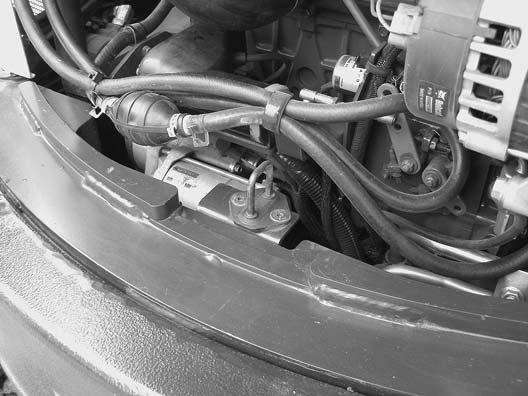

Warning
Keep the rear door closed when operating the machine. Failure to do so could seriously injure a bystander.
Adjusting The Latch
Pull the latch (Item 1) [Figure152] and open the tailgate. Push firmly to close the tailgate.
NOTE:The tailgate can be locked using the start key.
Open the tailgate to access the right side cover latch (Item 1) [Figure154]
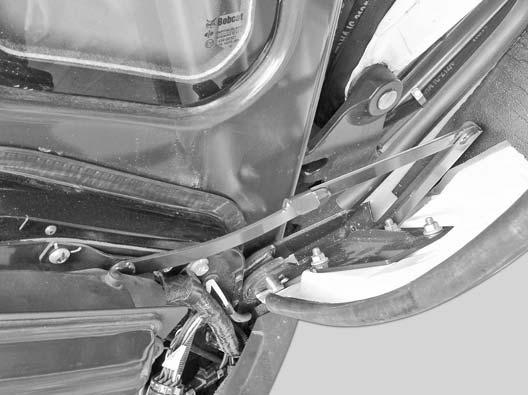

Pull up the lever (Item 1) and remove the latch (Item 2) [Figure154] from the latch post.
Raise the right side cover and rotate forward until it is held open by the retainer (Item 1) [Figure155]
To close the right side cover, lift up on the retainer (Item 1) [Figure155] while raising the right side cover. Rotate the cover back until it is in the fully closed position. Secure the right side cover with the latch (Item 2) and lever (Item 1) [Figure154].
Cab Filters
Cleaning And Maintenance
The recirculation filter and the fresh air filter must be cleaned regularly. (See SERVICE SCHEDULE on Page 99.)
The recirculation filter is located to the right of the operator seat and the fresh air filter is located under the right side cover.



Recirculation Filter
Figure 156
Turn the fastener (Item 1) 90° turn and open the cover (Item 2) [Figure 156]
157
Pull the filter (Item 1) [Figure 157] out of the heater housing.
Use low air pressure to clean the filter. Replace the filter when very dirty.
Installation: Install the filter with the arrows that indicate air flow direction (Item 2) [Figure 157] pointing toward the heater housing.
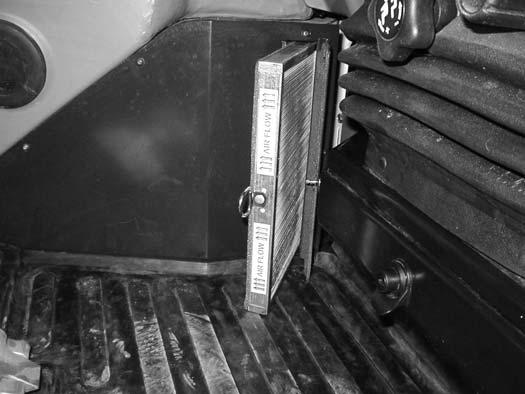
Fresh Air Filter
Figure158
Open the right side cover. (See Opening And Closing on Page 105.)
Turn the fastener (Item 1) 90° and remove the cover (Item 2) [Figure158]
Pull the filter (Item 1) [Figure159] out of the housing. Use low air pressure to clean the filter. Replace the filter when very dirty.
Air Cleaner Service
See the service schedule for the correct service interval. (See SERVICE SCHEDULE on Page 99.)
Daily Check
Figure160
Check the condition indicator (Item 1) [Figure160]. If the red ring shows in the condition indicator, the filter needs to be replaced.
Replace the inner filter every third time the outer filter is replaced or as indicated.

Replacing The Filter Elements
Outer Filter
Figure161
Open the latch (Item 1) [Figure161]
Remove and clean the dust cover (Item 2) [Figure161]
Figure162
Pull the outer filter (Item 1) [Figure162] from the air cleaner housing.
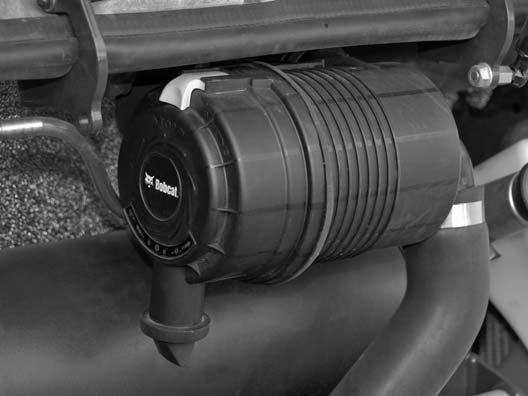
Check the housing for damage.
Clean the housing and the seal surface. DO NOT use compressed air.
Install a new filter.

AIR CLEANER SERVICE (CONT’D)
Replacing The Filter Elements (Cont’d)
Outer Filter (Cont’d)
Figure163
Install the dust cover (Item 3) [Figure163] by turning the cover clockwise.
Make sure the dust cap (Item 1) is installed and engage the latch (Item 2) [Figure163]
Check the air intake hose and the air cleaner housing for damage. Make sure all connections are tight.
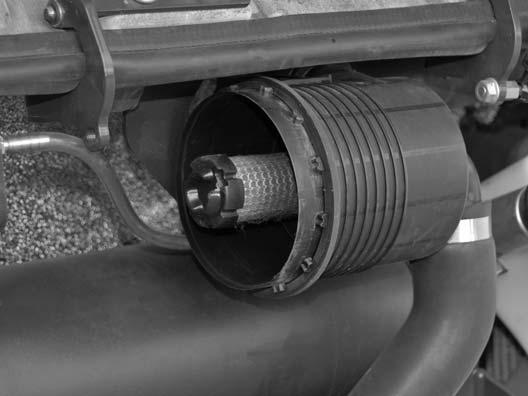

After the outer filter has been replaced, press the button (Item 2) [Figure160] on the end of the condition indicator.
Start the engine. (See STARTING THE ENGINE on Page 66.) Run at full rpm, then reduce engine speed. Stop the engine. (See STOPPING THE ENGINE AND LEAVING THE EXCAVATOR on Page 72.)
If the red ring (Item 1) [Figure160] shows in the condition indicator, replace the inner filter.
Inner Filter
Only replace the inner filter under the following conditions:
•Replace the inner filter every third time the outer filter is replaced.
•After the outer filter has been replaced, press the button (Item 2) [Figure160] on the condition indicator. Start the engine and run at full rpm, then reduce engine speed. Stop the engine. If the red ring shows in the condition indicator, replace the inner filter.
Remove the dust cover, outer filter and inner filter (Item 1) [Figure164]
NOTE:Make sure all sealing surfaces are free of dirt and debris.
Install the new inner filter.
Install the outer filter and the dust cover.
Press the button on the condition indicator to remove the red ring.
Fuel System
Fuel Specifications
Use only clean, high quality diesel fuel, Grade No. 2 or Grade No. 1.
The following is one suggested blending guideline which should prevent fuel gelling during cold temperatures:
Biodiesel Blend Fuel
Biodiesel blend fuel has unique qualities that should be considered before using in this machine:
•Cold weather conditions can lead to plugged fuel system components and hard starting.
•Biodiesel blend fuel is an excellent medium for microbial growth and contamination which can cause corrosion and plugging of fuel system components.
•Use of biodiesel blend fuel can result in premature failure of fuel system components, such as plugged fuel filters and deteriorated fuel lines.
At a minimum, low sulfur diesel fuel must be used in this machine. Low sulfur is defined as 500 mg/kg (500 ppm) sulfur maximum.
The following fuels may also be used in this machine:
•Ultra low sulfur diesel fuel. Ultra low sulfur is defined as 15 mg/kg (15 ppm) sulfur maximum.
•Biodiesel blend fuel - Must contain no more than five percent biodiesel mixed with low sulfur or ultra low sulfur petroleum based diesel. This is commonly marketed as B5 blended diesel fuel. B5 blended diesel fuel must meet ASTM D975 (US Standard) or EN590 (EU Standard) specifications.
Warning
AVOID INJURY OR DEATH
Stop and cool the engine before adding fuel. NO SMOKING! Failure to obey warnings can cause an explosion or fire.
W-2063-0807
Warning
AVOID INJURY OR DEATH
Always clean up spilled fuel or oil. Keep heat, flames, sparks or lighted tobacco away from fuel and oil. Failure to use care around combustibles can cause explosion or fire.
W-2103-0508
•Shorter maintenance intervals can be required, such as cleaning the fuel system and replacing fuel filters and fuel lines.
•Using biodiesel blended fuels containing more than five percent biodiesel can affect engine life and cause deterioration of hoses, tubelines, injectors, injector pump and seals.
Apply the following guidelines if biodiesel blend fuel is used:
•Ensure the fuel tank is as full as possible at all times to prevent moisture from collecting in the fuel tank.
•Ensure that the fuel tank cap is securely tightened.
•Biodiesel blend fuel can damage painted surfaces, remove all spilled fuel from painted surfaces immediately.
•Drain all water from the fuel filter daily before operating the machine.
•Do not exceed engine oil change interval. Extended oil change intervals can cause engine damage.
•Before machine storage; drain the fuel tank, refill with 100% petroleum diesel fuel, add fuel stabiliser and run the engine for at least 30 minutes.
NOTE:Biodiesel blend fuel does not have long term stability and should not be stored for more than 3 months.
FUEL SYSTEM (CONT’D)
Filling The Fuel Tank
Warning
AVOID INJURY OR DEATH
Stop and cool the engine before adding fuel. NO SMOKING! Failure to obey warnings can cause an explosion or fire.
W-2063-0807
Warning
AVOID INJURY OR DEATH
Always clean up spilled fuel or oil. Keep heat, flames, sparks or lighted tobacco away from fuel and oil. Failure to use care around combustibles can cause explosion or fire.
W-2103-0508
The fuel cap uses the start key to unlock the fuel cap.
Remove the fuel fill cap (Item 1) [Figure165].
Use a clean, approved safety container to add fuel. Add fuel only in an area that has a free movement of air and no flames or sparks. NO SMOKING!
Install and tighten the fuel fill cap. Clean up any spilled fuel.
See the service schedule for the service interval when to remove water from or replace the fuel filter. (See SERVICE SCHEDULE on Page 99.)
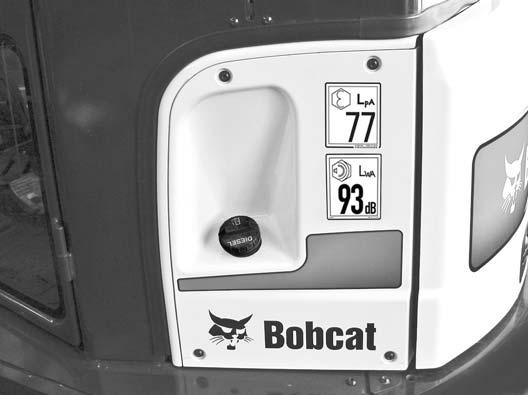
FUEL SYSTEM (CONT’D)
Fuel Filter
Removing Water
Open the tailgate. (See TAILGATE on Page 104.)
See the service schedule for the correct service interval. (See SERVICE SCHEDULE on Page 99.)
Figure166
Loosen the drain (Item 1) [Figure166] at the bottom of the filter to drain water from the filter into a container.
Clean up any spilled fuel.
Replacing Elements
Remove the filter (Item 2) [Figure166]
Clean the area around the filter housing. Put clean oil on the seal of the new filter. Install the fuel filter and hand tighten.
Remove the air from the fuel system. (See Removing Air From The Fuel System on Page 112.)

Draining The Fuel Tank
See the service schedule for the correct service interval. (See SERVICE SCHEDULE on Page 99.)
Figure167
Remove the drain plug (Item 1) [Figure167]

Drain the fuel into the container.
Reuse, recycle or dispose of fuel in an environmentally safe manner.
Reinstall the drain plug.
Warning
Avoid Injury Or Death
Diesel fuel or hydraulic fluid under pressure can penetrate skin or eyes, causing serious injury or death. Fluid leaks under pressure may not be visible. Use a piece of cardboard or wood to find leaks. Do not use your bare hand. Wear safety goggles. If fluid enters skin or eyes, get immediate medical attention from a doctor familiar with this injury.
W-2072-EN-0909
FUEL SYSTEM (CONT’D)
Removing Air From The Fuel System
After replacing the fuel filter or when the fuel tank has run out of fuel, air must be removed from the fuel system before starting the engine.
Open the tailgate. (See Opening And Closing on Page 104.)
Warning
Avoid Injury Or Death
Diesel fuel or hydraulic fluid under pressure can penetrate skin or eyes, causing serious injury or death. Fluid leaks under pressure may not be visible. Use a piece of cardboard or wood to find leaks. Do not use your bare hand. Wear safety goggles. If fluid enters skin or eyes, get immediate medical attention from a doctor familiar with this injury.
W-2072-EN-0909
Open the fuel filter vent (Item 1) [Figure168] and operate the hand pump (priming bulb) (Item 2) [Figure169] until the fuel flows from the vent with no air bubbles.

Close the vent (Item 1) [Figure168]
Start the engine. It may be necessary to open the vent (Item 1) [Figure169] (at the fuel injection pump) briefly until the engine runs smoothly.

Engine Lubrication System
Checking And Adding Engine Oil
Check the engine oil after every 8 - 10 hours of operation and before starting the engine. (See SERVICE SCHEDULE on Page 99.)

Figure170
Open the tailgate and remove the dipstick (Item 1) [Figure170]
Keep the oil level between the marks on the dipstick.
Use a good quality motor oil that meets the correct API Service Classification. (See LUBRICANTS AND FLUIDS on Page 10.)
Engine Oil Chart

Figure171
ENGINE OIL RECOMMENDED SAE VISCOSITY NUMBER (LUBRICATION OILS FOR DIESEL ENGINE CRANKCASE)
TEMPERATURE RANGE ANTICIPATED BEFORE NEXT OIL CHANGE (DIESEL ENGINES MUST USE API CLASSIFICATION CI-4 OR BETTER)
[1] Synthetic Oil - Use recommendation from Synthetic Oil Manufacturer.
Use good quality engine oil that meets API Service Classification of CI-4 or better [Figure171].
Warning
Avoid Injury Or Death
Always clean up spilled fuel or oil. Keep heat, flames, sparks or lighted tobacco away from fuel and oil. Failure to use care around combustibles can cause explosion or fire.
W-2103-0508
ENGINE LUBRICATION SYSTEM (CONT’D)
Removing And Replacing Oil And Filter
See the service schedule for the service interval for replacing the engine oil and filter. (See SERVICE SCHEDULE on Page 99.)
Rotate upperstructure so that the oil drain plug and the oil filter access cover is between the tracks.
Run the engine until it is at operating temperature. Stop the engine.
Open the tailgate. (See Opening And Closing on Page 104.)
Remove the oil filter (Item 1) [Figure173] and clean the filter housing surface.
Use a genuine Bobcat replacement filter. Put clean oil on the filter gasket. Install the filter and hand tighten.
Install and tighten the drain plug (Item 1) [Figure172].
Place a container under the oil pan. Remove the drain plug (Item 1) [Figure172] from the bottom of the engine oil pan.
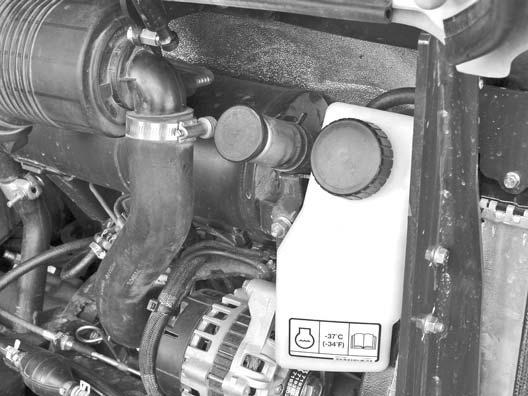


Recycle or dispose of used oil in an environmentally safe manner.
Remove the fill cap (Item 1) [Figure174]
Put oil in the engine. (See Checking And Adding Engine Oil on Page 113.)
Install the fill cap (Item 1) [Figure174].
Start the engine and let it run for several minutes.
Stop the engine. Check for leaks at the oil filter. Check the oil level.
Add oil as needed if it is not at the top mark on the dipstick.
Engine Cooling System
Check the cooling system every day to prevent overheating, loss of performance or engine damage. (See SERVICE SCHEDULE on Page 99.)
Cleaning
Open the right side cover. (See Opening And Closing on Page 105.)
NOTE:Allow the cooling system and engine to cool before servicing or cleaning the cooling system.
Slide the knob (Item 1) out of the radiator mounting bracket (Item 2) [Figure177]. Be careful not to damage fins.
Turn the two quarter turn fasteners (Item 1) and remove the rear side cover (Item 2) [Figure175]
Use air pressure or water pressure to clean the radiator (Item 1) and oil cooler (Item 2) [Figure178]. Be careful not to damage fins when cleaning.
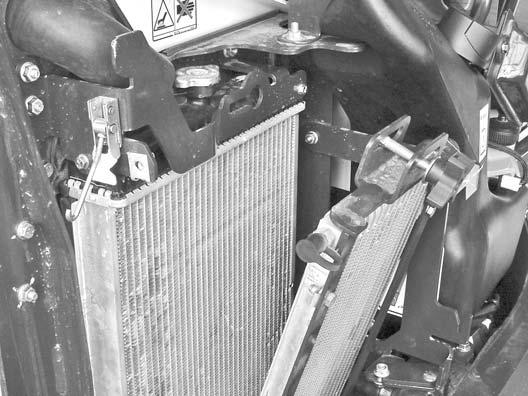



Position the knob (Item 1) so it fits into the radiator mount (Item 2) [Figure177].
Slide the knob (Item 1) toward the rear of the machine until it is fully seated in the slots of the mounting bracket. Tighten the knob (Item 1) [Figure176]. Be careful not to damage fins.
Loosen the knob (Item 1) [Figure176]. Slide the knob toward the front of the machine.
Reinstall the rear side cover (Item 2) and turn the quarter turn fasteners (Item 1) [Figure175] to secure the rear side cover.
ENGINE COOLING SYSTEM (CONT’D)

Checking Level
Warning
AVOID BURNS
Do not remove radiator cap when the engine is hot. You can be seriously burned.
W-2070-1203
Warning
AVOID INJURY OR DEATH
Wear safety glasses to prevent eye injury when any of the following conditions exist:
•When fluids are under pressure.
•Flying debris or loose material is present.
•Engine is running.
•Tools are being used.
Important
AVOID ENGINE DAMAGE
W-2019-0907
Open the tailgate. (See Opening And Closing on Page 104.)
Figure179
S39324
Check the coolant level in the coolant recovery tank (Item 1) [Figure179]
The coolant level must be filled to the COLD FILL line marked on the on the coolant recovery tank.
NOTE:The cooling system is factory filled with propylene glycol (purple colour). DO NOT mix propylene glycol with ethylene glycol.
Use a refractometer to check the condition of propylene glycol in your cooling system.
Always use the correct ratio of water to antifreeze.
Too much antifreeze reduces cooling system efficiency and may cause serious premature engine damage.
Too little antifreeze reduces the additives which protect the internal engine components; reduces the boiling point and freeze protection of the system.
Always add a premixed solution. Adding full strength concentrated coolant can cause serious premature engine damage.
I-2124-0497
ENGINE COOLING SYSTEM (CONT’D)

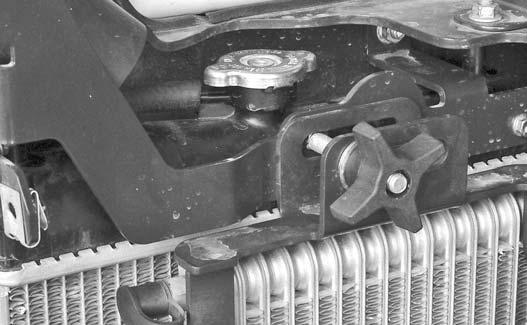
Removing And Replacing Coolant
See the service schedule for correct service intervals. (See SERVICE SCHEDULE on Page 99.)
Stop the engine. Open the tailgate. (See Opening And Closing on Page 104.)
Warning
AVOID BURNS
Do not remove radiator cap when the engine is hot. You can be seriously burned.
W-2070-1203
Install a hose on the drain valve at the bottom of the radiator. Open the drain valve (Item 1) [Figure181] and drain the coolant into a container.
After all the coolant is removed, close the drain valve (Item 1) [Figure181]
Recycle or dispose of the used coolant in an environmentally safe manner.
Mix the coolant in a separate container. (See Capacities on Page 155.)
NOTE:The cooling system is factory filled with propylene glycol (purple colour). DO NOT mix propylene glycol with ethylene glycol.
When the engine is cool, loosen and remove the coolant fill cap (Item 1) [Figure180]
The correct mixture of coolant to provide a -37°C (-34°F) freeze protection is 5 L propylene glycol mixed with 4,4 L of water OR 1 U.S. gal propylene glycol mixed with 3.5 qt of water.
Add premixed coolant, 47% water and 53% propylene glycol to the radiator. Install the coolant fill cap (Item 1) [Figure180]
Add premixed coolant to the recovery tank (Item 1) [Figure179] until the coolant level reaches the COLD FILL line marked on the on the coolant recovery tank.
Run the engine until it is at operating temperature. Stop the engine. Check the coolant level when cool. Add coolant as needed. Install the coolant fill cap.
Close the tailgate.









